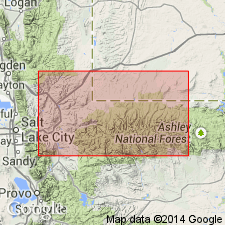
- Usage in publication:
-
- Jensen Member
- Modifications:
-
- Named
- Dominant lithology:
-
- Siltstone
- AAPG geologic province:
-
- Great Basin province
Summary:
Shown in correlation chart as uppermost member of Chainman Formation in Silver Island Range, western UT. [Chart shows composed of siltstone.] Overlies Willow Spring member (new) (Chainman Formation). Underlies Ely Limestone. Age shown as Mississippian and Pennsylvanian. "The Jensen and Willow Spring members will be introduced subsequently." p.251. [Note that Walter Sadlick (1966) later introduced Jensen member of Chainman Formation in PhD thesis (Dissertation Abstracts v.26 p.5978).]
Source: GNU records (USGS DDS-6; Menlo GNULEX).
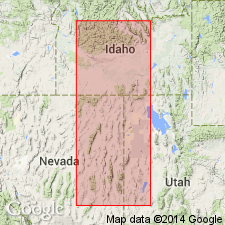
- Usage in publication:
-
- Jensen Member
- Modifications:
-
- Areal extent
- Biostratigraphic dating
- AAPG geologic province:
-
- Great Basin province
Summary:
Measured section described on south face of west-trending spur in NE/4 sec.32 T17N R58E, White Pine Co, NV is 518 ft thick. "Jensen Member" of Chainman Shale is used in place of "Illipah Formation" (of old reports). Also shown in stratigraphic column as in Springer-Morrowan Series (CRAVENOCERAS SPP. and RHIPIDOMELLA NEVADENSIS Zones). Age given as Mississippian and Pennsylvanian.
Source: GNU records (USGS DDS-6; Menlo GNULEX).
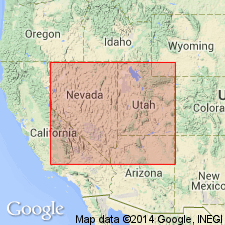
- Usage in publication:
-
- Jensen Member
- Modifications:
-
- Age modified
- Biostratigraphic dating
- AAPG geologic province:
-
- Great Basin province
Summary:
Jensen Member is uppermost member (of 6) of Chainman Formation along UT-NV boundary. Is an alluvial coastal plain and neritic facies. Thickness is about 450 ft. Lower part contains Namurian Zone of TUMULITES EUMORPHOCERAS YARIANS (late Chesterian) in which CRAVENOCERAS HESPERIUM is prolific. Uppermost part of unit contains RHIPIDOMELLA NEVADENSIS Zone. Age is Late Mississippian.
Source: GNU records (USGS DDS-6; Menlo GNULEX).
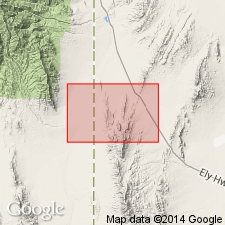
- Usage in publication:
-
- Jensen Member*
- Modifications:
-
- Mapped 1:24k
- Dominant lithology:
-
- Siltstone
- Limestone
- AAPG geologic province:
-
- Great Basin province
Summary:
Is mapped as uppermost member (Chesterian) of Chainman Formation (Mississippian) in Mountain Home Range in western Millard Co, southwest UT (Great Basin province). Subdivisions of the Chainman mostly follow Sadlick (1965) with addition of two members [units] below his Needle Member. Sandberg and others (1980) have listed conodont zones using Sadlick's subdivisions. Overlies Willow Gap Limestone Member of Chainman (Chesterian). Overlain by Ely Limestone (Lower Permian, Pennsylvanian, and Upper Mississippian). Map unit described as thin-bedded calcareous siltstone and limestone that weathers reddish to yellowish brown; brachiopods, crinoid stems, blastoids, bryozoans and other fossils weather abundantly from some thin shaly limestone beds; includes a few thin quartzite beds; forms slopes and saddles between more resistant enclosing units; thickness ranges from 120 m in The Cove to 80 m on east flank of the Mountain Home Range.
Source: GNU records (USGS DDS-6; Denver GNULEX).
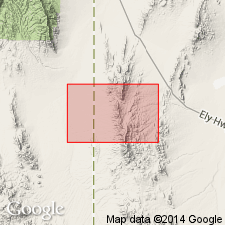
- Usage in publication:
-
- Jensen Member*
- Modifications:
-
- Mapped 1:24k
- Dominant lithology:
-
- Siltstone
- Limestone
- AAPG geologic province:
-
- Great Basin province
Summary:
Is mapped as uppermost member (Chesterian) of Chainman Formation (Mississippian) in central part of Mountain Home Range in western Millard Co, southwest UT (Great Basin province). Subdivisions of the Chainman mostly follow Sadlick (1965, 1966) with addition of Delle Phosphatic Member (Sandberg and Gutschick, 1984) at base of formation. Sandberg and others (1980) have listed Chainman conodont zones using Sadlick's subdivisions. Overlies Willow Gap Limestone Member of Chainman (Chesterian). Overlain by Ely Limestone (Lower Permian, Pennsylvanian, and Upper Mississippian). Map unit described as thin-bedded calcareous siltstone and limestone that weathers reddish to yellowish brown; brachiopods, crinoid stems, blastoids, bryozoans and other fossils abundant in some thin shaly limestone interbeds; includes a few thin quartzite beds; forms slopes below more-resistant Ely Limestone; thickness 85 m in sec. 34, T25S, R19W.
Source: GNU records (USGS DDS-6; Denver GNULEX).
For more information, please contact Nancy Stamm, Geologic Names Committee Secretary.
Asterisk (*) indicates published by U.S. Geological Survey authors.
"No current usage" (†) implies that a name has been abandoned or has fallen into disuse. Former usage and, if known, replacement name given in parentheses ( ).
Slash (/) indicates name conflicts with nomenclatural guidelines (CSN, 1933; ACSN, 1961, 1970; NACSN, 1983, 2005, 2021). May be explained within brackets ([ ]).

